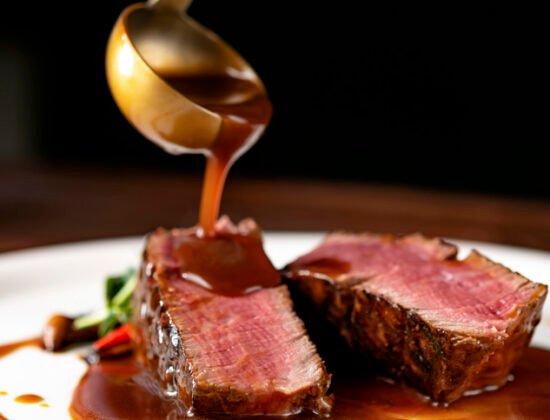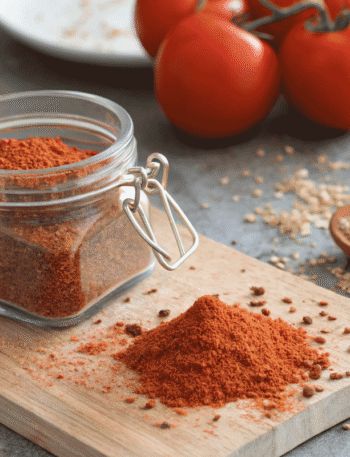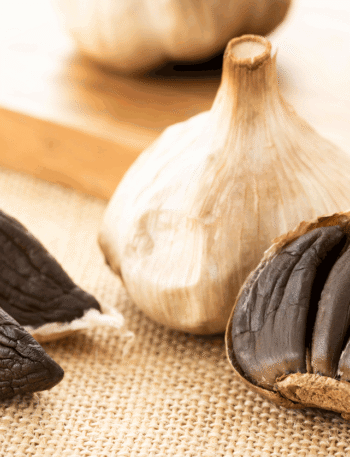Demi-glace is one of those rich, glossy sauces that instantly elevates a dish. If you’ve ever had a perfectly seared steak topped with a deep brown reduction or a velvety mushroom sauce with layers of flavor, you’ve probably tasted it — even if you didn’t know what it was.
In classic French cooking, demi-glace is a cornerstone. It’s not just a sauce, but a building block for other sauces. And while it may sound fancy or difficult, it’s actually something you can make at home with a little time and patience.
Let’s explore what makes demi-glace so important, where it comes from, how it works, and why it’s worth making from scratch.
A Quick History: Escoffier and the Mother Sauces
To understand demi-glace, it helps to go back to Auguste Escoffier, the French chef who codified much of what we now call classical French cuisine. In the early 1900s, Escoffier built on earlier traditions and organized sauces into five “mother sauces”: béchamel, velouté, espagnole, hollandaise, and tomato.
Demi-glace comes from espagnole, the brown sauce made from roasted bones, mirepoix (onions, carrots, and celery), and tomato paste. Escoffier’s version of demi-glace was essentially a 1:1 mix of espagnole and brown stock, simmered and reduced until it became rich and syrupy. This thickened base became the foundation for many other sauces in French cooking.
Today, demi-glace is still used in restaurants around the world, but it’s also gaining popularity among home cooks who want to deepen their flavors beyond what a bouillon cube can offer.
So What Exactly Is Demi-Glace?
At its core, demi-glace is a highly reduced brown stock, often made with veal or beef bones, aromatics, tomato paste, and sometimes wine. The result is a dark, silky sauce that delivers concentrated umami — the savory taste that makes food feel complete.
Because the liquid is simmered for hours and then reduced again, the flavors are deep and complex. This isn’t a sauce you throw together at the last minute. It’s more of a kitchen project that pays off in the long run.
Demi-glace isn’t typically served on its own. Instead, it’s used to finish other sauces, enrich stews, or give body to pan sauces and reductions.
How It’s Made
The traditional method starts with roasting bones — usually veal or beef — to develop flavor and color. These bones are simmered with aromatics and tomato paste to make a brown stock. That stock is then reduced, strained, and combined with espagnole sauce before reducing even further.
But there are plenty of modern twists.
For example, I like to use pork neck bones instead of veal. They’re easier to find, more affordable, and still give great body to the sauce. Some cooks also simplify by skipping the espagnole entirely and just reducing the stock with wine, tomato, and vegetables until it reaches a syrupy consistency. While this version is technically not a classic demi-glace, it still brings the same flavor benefits to the table.
You can find my full recipe here.
Why It’s Worth Making
Demi-glace is all about depth. You’re not just adding salt or richness to a dish — you’re adding something that tastes like it’s been cooking all day, even when it hasn’t.
A spoonful of homemade demi-glace can transform:
- A pan sauce for steak, chicken, or duck
- A mushroom ragout or sauté
- Red wine or brandy-based reductions
- Soups or stews that need extra richness
- Risotto, rice, or pasta dishes with savory sauces
It’s especially useful for creating restaurant-quality meals at home without relying on artificial flavor boosters.
Umami and the Science of Flavor
Part of what makes demi-glace so satisfying is its umami content. As bones, meat scraps, and vegetables simmer, they release glutamates — natural compounds that enhance savory taste. This is the same effect you get from aged cheese, miso, or soy sauce.
Long simmering also breaks down collagen in the bones, which gives the sauce a silky texture. As the sauce reduces, the water evaporates and the flavors concentrate. It’s not just cooking — it’s flavor engineering.
Storage and Everyday Use
One of the best things about demi-glace is how well it stores. You can:
- Freeze it in ice cube trays or small containers
- Keep it frozen for several months
- Pull out a cube or two whenever you need a flavor boost
It’s like having a flavor bomb ready to go in your freezer. Add it to a quick pasta sauce, stir it into beans or lentils, or swirl it into pan juices after searing meat.
Once you start using it, you’ll wonder how you ever cooked without it.
Final Thoughts
Making demi-glace at home takes time, but it’s more accessible than it sounds. With a little planning and a few simple ingredients, you can create a rich, versatile sauce that adds depth to nearly any savory dish. And once you make a batch, you’ll find endless ways to use it — from elegant dinner parties to quick weekday meals.
Whether you’re a home cook looking to level up or a seasoned pro returning to the classics, demi-glace is one of those staples that never goes out of style.
Here’s a link to my version of demi-glace!




